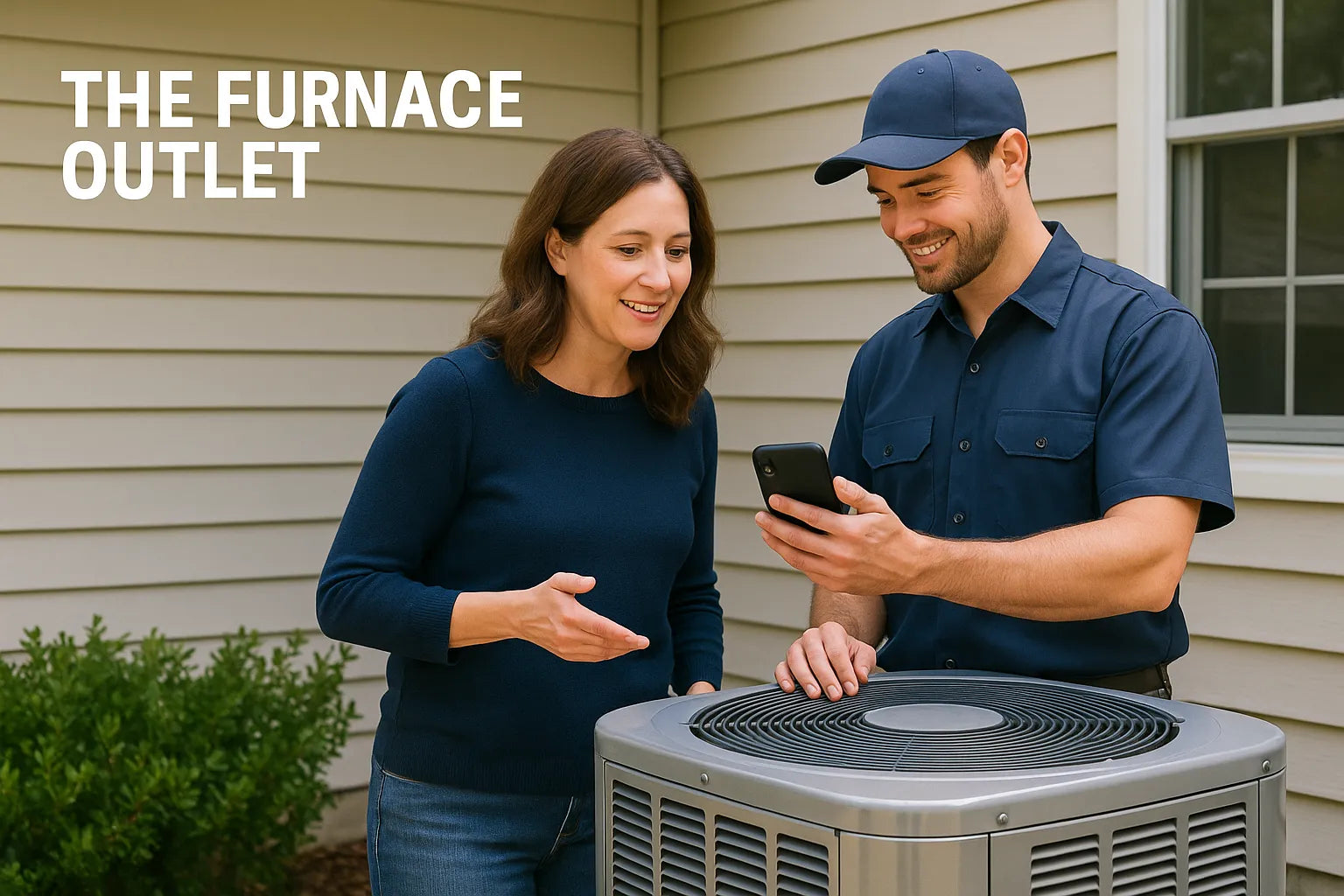Inside the Box: How Gas and Electric Furnaces Heat
A gas furnace converts natural gas chemical energy to heat with a burner, exchanger, and draft system. In 2025, high-efficiency units push 96 %+ AFUE by reclaiming latent flue heat. Electric furnaces skip combustion entirely; strip-heat elements glow like giant toaster coils, and a blower moves air across them. Fewer moving parts mean quieter runs and nearly zero vibration.
One BTU equals ≈0.293 Wh. A 60,000 BTU gas furnace outputs the same heat as a 17.6 kW electric element but will draw only ~600 W for blowers versus 17 kW from the grid.
Blower sizing, cabinet insulation, and return-air design matter equally for both types. Explore current models in our furnace collection.
Up-Front Costs in 2025: Equipment, Labor, and Hidden Extras
Electric models still win on sticker price: $2 k–$7.5 k installed, because no gas piping, vent stack, or condensate drain is required. Gas units start near $2.5 k and can top $9.8 k once you add stainless venting or two-stage thermostats. Permit fees vary—some cities now charge carbon surcharges on new gas lines.
Need precise numbers? Our Design Center will review your Manual J and return a parts list within one business day.
Operating-Cost Math: kWh, Therms, and Load Profiles
Natural gas averages 9 ¢/kWh-equivalent in 2025, while grid electricity sits around 20 ¢/kWh. For a 40 MBH seasonal load, a gas furnace may cost ~$550/year; an equivalent electric unit can exceed $1,200 even before demand surcharges.
Annual Cost ≈ (Seasonal BTU ÷ AFUE) × Fuel Rate
Because electric rates often include tiered pricing, load shifting (pre-heating in shoulder hours) matters. Pairing your electric air handler with a smart thermostat and a 5 kWh battery can shave 15 % off bills. See compatible air handlers ready for demand-response relays.
Climate Fit: Heat Output Curves & Recovery Times
Gas furnaces excel at rapid recovery—ideal when outdoor temps plunge below -5 °C. Their burner can dump 100 % output instantly, minimizing morning warm-up. Electric coils ramp more slowly and may cycle longer, making them better for mild winters (above 0 °C design temp) where steady low heat wins.
Gas heat is drier; add a bypass humidifier if indoor RH dips under 30 %. Electric keeps humidity stable but may feel less “toasty.”
For mixed climates, dual-fuel packages switch from heat pump to gas automatically. Browse dual-fuel packaged units.
Environmental Footprint: AFUE vs Grid Mix Reality Check
Combustion emits CO₂ (~117 lbs/MMBtu) plus NOₓ. Even a 98 % AFUE furnace still vents ~3 tons of CO₂/year in a 2,000 ft² Chicago home. Electric furnaces produce zero on-site emissions; their true carbon cost mirrors your grid. If your utility is 45 % renewable, running electric cuts lifecycle CO₂ by roughly 40 % over gas. Check your regional mix at powercompare.gov.
The EPA’s 2025 Inflation Reduction Credits favor electric heating when the site-to-source ratio < 1.8.
Pair an electric furnace with rooftop PV, and you can drive net-heating emissions near zero. Ask about R-32 heat-pump systems if cooling is also on your list.
Comfort Engineering: Airflow, Humidity, and Temperature Swing
Gas furnaces deliver hotter supply air (110–140 °F), creating rapid stratification. Use variable-speed blowers to temper swings and keep throws quiet. Electric units push 90–100 °F supply, often requiring higher CFM; size ducts for ≤0.08 in w.c. friction to prevent whistling.
Add a bypass humidifier on gas or an ECM blower on electric for consistent 35–45 % RH ideal for wood floors and sinuses alike.
Concerned about allergens? Electric furnaces accept thicker MERV-13 filters without combustion-air starvation risks. Stock up on deep media cabinets in our accessories.
Safety & Service: From Flame Rollout to Element Burnout
Gas systems need annual combustion analysis, heat-exchanger inspection, and CO detector checks. Flame rollout, blocked flues, or cracked exchangers can leak carbon monoxide. Electric furnaces sidestep combustion hazards but demand vigilance on high-amp wiring: loose lugs overheat.
Maintenance Matrix
• Gas: Inspect burners (1 yr), exchanger (2 yr), pressure-switch tubing (1 yr).
• Electric: Torque check lugs (1 yr), vacuum elements (2 yr), test sequencers (2 yr).
Replacement igniters, sequencers, and boards ship same-day from our help center to minimize downtime.
Beyond Binary: Why Heat Pumps Are Stealing the Show
Modern cold-climate heat pumps hit 300 % COP at 0 °C—triple the efficiency of strip heat. They also cool in summer, replacing an aging AC and furnace in one chassis. When paired with an electric furnace, the coils serve as back-up heat only during deep freezes. This hybrid cuts winter bills up to 40 %.
Explore ductless mini-split lines for zoned retrofits or packaged R-32 rooftop units for light commercial roofs.
Decision Matrix: Budget, Climate, and Sustainability Goals
|
Your Priority |
Best Choice |
Why |
|
Lowest first-cost, mild winters |
Electric Furnace |
Cheaper install; adequate heat |
|
Lowest lifetime cost, cold zone |
High-Eff Gas |
Fuel is cheaper; faster recovery |
|
Small carbon footprint |
Heat Pump + PV |
0 % on-site CO₂; cooling bonus |
|
Allergy-safe indoor air |
Electric |
No combustion; supports MERV-13 |
|
|
Use this table with your Manual J load to narrow options, then price-check packages under our Lowest Price Guarantee.
Field-Tested Installation & Sizing Tips
-
Never oversize. Aim for 90–100 % of design load; gas short-cycling slashes AFUE by 10 %.
-
Return-air rule: 2 in² per 1,000 BTU for gas; 2.5 in² for electric’s higher CFM.
-
Gas vent pitch: ¼ in/ft upward, PVC on 90 %+ condensing models.
-
Electric breaker sizing: 125 % of element amp draw per NEC 424.3(B).
-
Commissioning: Clock the gas meter or log kWh to confirm rated input within ±3 %.







